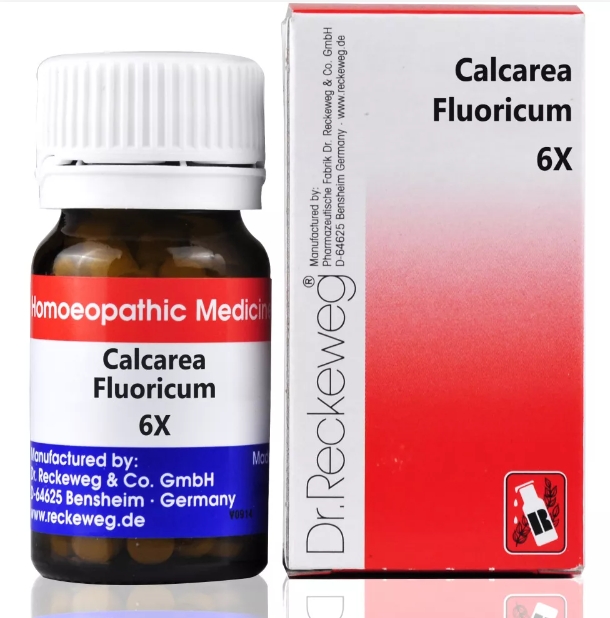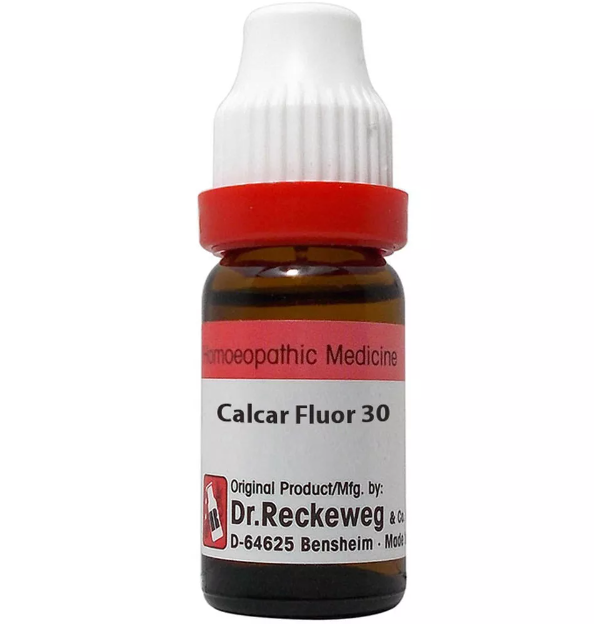CALCAREA FLUORICA-FLUOR SPAR. 3x, 6x, 12x, 30x, 200x, 6C, 12C, 30C, 200C, 1M, 10M USES AND SYMPTOMS
 Calcarea Fluorica – Fluor Spar (Fluoride of Lime)
Calcarea Fluorica – Fluor Spar (Fluoride of Lime)
A potent remedy for hard, stony glands, varicose and enlarged veins, and bone malnutrition. Effective for hard knots in the female breast, goitre, congenital syphilis, and indurations threatening to suppurate. Beneficial for cataracts, congenital syphilis with ulceration of mouth and throat, caries and necrosis with boring pains and heat, arteriosclerosis, threatened apoplexy, and tuberculosis. Post-surgery, it reduces the tendency to adhesions.
Mind: Profound depression and irrational fears of financial ruin.
Head: Creaking noises, blood tumors in infants, hard excrescences, and callous ulcers on the scalp.
Eyes: Flickering and sparks, spots on the cornea, conjunctivitis, cataracts, and subcutaneous palpebral cysts.
Ears: Calcareous deposits, sclerosis with deafness, ringing, roaring, and chronic suppuration of the middle ear.
Nose: Stuffy cold, dry coryza, ozena, and thick, offensive nasal catarrh. Prominent crusts in atrophic rhinitis.
Face: Painful hard swelling on the cheek and jawbone.
Mouth: Hard gum-boil, cracked or indurated tongue, loose teeth, and toothache from food contact.
Throat: Follicular tonsillitis with continuous mucus plugs, burning pain better with warm drinks, hypertrophy of Luschka’s tonsil, and relaxed uvula.
Stomach: Vomiting in infants, undigested food, hiccough, flatulence, nausea, and acute indigestion from fatigue.
Rectum: Diarrhea in gouty individuals, anal fissures, itching, bleeding hemorrhoids, and wind in the lower bowels, worsened by pregnancy.
Male: Hydrocele and testicular indurations.
Respiratory: Hoarseness, croup, cough with yellow mucus, spasmodic cough, and removal of fibroid deposits around the endocardium.
Circulatory System: Remedy for vascular tumors, varicose veins, aneurisms, and valvular disease.
Back: Chronic lumbago, osseous tumors, rachitic femur enlargement, and burning pain in the lower back.
Extremities: Ganglia, gouty joint enlargements, exostoses on fingers, and chronic synovitis of the knee.
Sleep: Vivid dreams and unrefreshing sleep.
Skin: White skin, scar tissue, chaps, cracks, suppurations with callous edges, fistulous ulcers, hard glands, and stony indurations.
Modalities: Worse during rest and weather changes; better with heat and warm applications.
Relationship: Compare with Con., Lap-a., Bar-m., Hecla, Rhus-t., Natrium cacodylicum (tumors).
Dose: Third to twelfth trituration. A chronic remedy that needs time to show effects and should not be repeated too frequently.
SYMPTOMS OF CALCAREA FLUORICA -FLUOR SPAR.
Mind:
Great depression
Groundless fears of financial ruin
Head:
Creaking noise in the head
Blood tumors (aneurysms) in newborn infants
Hard excrescences on the scalp
Ulcers on the scalp with callous, hard edges
Eyes:
Flickering and sparks before the eyes
Spots on the cornea
Conjunctivitis
Cataract
Subcutaneous palpebral cysts
Ears:
Calcareous deposits on tympanum
Sclerosis of ossicula and petrous portion of temporal bone leading to deafness, ringing, and roaring
Chronic suppuration of middle ear
Nose:
Cold in the head
Stuffy cold
Dry coryza
Ozena
Atrophic rhinitis, especially with prominent crusts
Face:
Hard swelling on cheek with pain or toothache
Hard swelling on jaw bone
Mouth:
Gum-boil with hard swelling on jaw
Cracked appearance of tongue
Induration and hardening of tongue after inflammation
Unnatural looseness of teeth
Toothache worsened by food contact
Throat:
Follicular sore throat
Tonsillar plugs of mucus
Pain and burning in throat worsened by cold drinks
Hypertrophy of Luschka’s tonsil
Relaxed uvula
Stomach:
Vomiting in infants
Vomiting of undigested food
Hiccough
Flatulence
Weakness and daintiness of appetite
Nausea and distress after eating in overtaxed children
Rectum:
Diarrhea in gouty subjects
Anal fissures
Itching in anus
Bleeding hemorrhoids
Marked wind in lower bowels worsened during pregnancy
Male:
Hydrocele
Indurations of testicles
Respiratory:
Hoarseness
Croup
Cough with expectoration of tiny lumps of yellow mucus
Spasmodic cough
Circulatory System:
Vascular tumors with dilated blood vessels
Varicose or enlarged veins
Aneurysms
Valvular disease
Tuberculous toxins affecting heart and blood vessels
Back:
Chronic lumbago
Osseous tumors
Rachitic enlargement of femur in infants
Pain in lower back with burning
Extremities:
Ganglia or encysted tumors
Gouty enlargements in joints
Exostoses
Chronic synovitis of knee joint
Sleep:
Vivid dreams with sense of impending danger
Unrefreshing sleep
Skin:
Marked whiteness of skin
Scar tissue
Chaps and cracks
Fissures or cracks on palms of hands
Anal fissures
Suppurations
Indolent ulcers
Hardened glands in female breast
selection of the potency
Individualization:
- Homeopathy is based on the principle of treating the individual, not just the disease. The unique symptoms and characteristics of the person are crucial in determining the most suitable potency.
Intensity of Symptoms:
- The intensity of the symptoms guides the choice of potency. If the symptoms are intense and acute, a lower potency (e.g., 6C, 30C) might be considered. For chronic conditions with less intensity, higher potencies (e.g., 200C, 1M) may be appropriate.
Sensitivity of the Patient:
- Some individuals are more sensitive to homeopathic remedies, while others may require higher potencies. The practitioner considers the patient’s sensitivity when selecting the potency.
Acute vs. Chronic Conditions:
- Lower potencies are often used for acute conditions, while higher potencies may be considered for chronic or long-standing issues.
Previous Response to Potencies:
- The patient’s response to previous homeopathic treatments helps guide the choice of potency. If a particular potency has been effective in the past, it may be repeated or adjusted as needed.
Vital Force and Susceptibility:
- Homeopathy views illness as a disturbance in the vital force. The practitioner assesses the patient’s overall vitality and susceptibility to determine the appropriate potency.
Aggravation or Amelioration:
- The direction of the symptom response (aggravation or amelioration) after taking a remedy can influence the choice of potency.
Miasmatic Considerations:
- In classical homeopathy, the concept of miasms (inherited disease tendencies) is considered. The practitioner take this into account when selecting the potency.
Practitioner Experience:
- The experience and preference of the homeopathic practitioner play a role. Some practitioners may have success with certain potencies based on their clinical experience.
SAFETY INFORMATION
- Do not exceed the recommended dose by physician
- Keep out of the reach of children
- Store in a cool dry place away from direct sunlight
- Maintain half an hour gap between food/drink/any other medicines and homoeopathic medicine
- Avoid any strong smell in the mouth while taking medicine e.g. camphor, garlic, onion, coffee, hing
Medicine images use for reference only selection of homeopathic medicine depends on the individual’s specific symptoms and overall constitution. Moreover, homeopathy is a holistic system of medicine that treats the individual as a whole. In addition to addressing the physical symptoms, it takes into account the emotional and mental state of the person. Consequently, it’s crucial to consult with a qualified homeopathic practitioner for personalized treatment.
The information provided on this website is intended solely for educational purposes. Always seek the advice of your physician or other qualified health provider.
